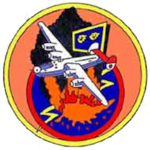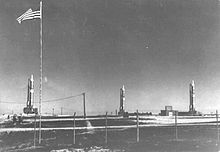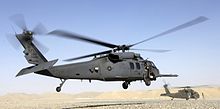451st Air Expeditionary Group
This article needs to be updated. The reason given is: withdrawal of US troops from Afghanistan. (February 2023) |
| 451st Air Expeditionary Group | |
|---|---|
War in Afghanistan (2001-2021) | |
| Insignia | |
| 451st Air Expeditionary Wing emblem |  |
| 451st Strategic Missile Wing emblem (Approved 29 June 1962)[1] |  |
| Unofficial 451st Bombardment Group emblem[2] |  |
The 451st Air Expeditionary Group was a provisional
The
During the
Units
- MQ-9 Reaper)[3]
- 73d Expeditionary Air Control Squadron
- 303d Expeditionary Fighter Squadron
- 361st Expeditionary Reconnaissance Squadron
- 430th Expeditionary Electronic Combat Squadron
- 451st Expeditionary Operations Support Squadron
- 772d Expeditionary Airlift Squadron
- 451st Expeditionary Communications Squadron
- 451st Expeditionary Civil Engineering Squadron
- 451st Expeditionary Logistics Readiness Squadron
- 451st Expeditionary Security Forces Squadron
- 451st Expeditionary Force Support Flight
Tenant units
- 466th Air Expeditionary Squadron
- 809th RED HORSE Squadron
- 777th Expeditionary Prime BEEF Squadron
- 807th Expeditionary Air Support Operations Squadron
History
World War II
Organization and training in the United States
The first predecessor of the
Combat operations
The group arrived at
When returning from the Regensburg attack, runway conditions at Gioia del Colle were so poor that the aircraft of the 451st Group were unable to land there, but spread out among a number of bases in Italy. These poor conditions continued and on 8 March group headquarters and the 724th and 726th Squadrons moved to San Pancrazio Airfield, Italy, while the 725th and 727th Squadrons moved to Manduria Airfield.[9]
On 6 April, the group assembled at
The group left Italy in June 1945, with the air echelon ferrying their planes, while most of the ground echelon sailed on the
Strategic Air Command

The second predecessor of the group was organized at
On 19 November 1964, Defense Secretary Robert McNamara announced the phase-out of remaining first-generation SM-65 Atlas and Titan I missiles by the end of June 1965. This objective was met. All wing missiles went off alert status on 26 March 1965 and the wing phased down for inactivation. On 25 June 1965, the wing and the 724th and 725th Squadrons were inactivated.[1] SAC removed the last missile from Lowry on 14 April 1965.[citation needed]
War in Afghanistan

The 451st Air Expeditionary Group was activated in 2002, conducting operations from Kandahar Airfield, Afghanistan. The group was responsible for air control of the southern region of Afghanistan, launch and recovery operations for the MQ-1 Predator and MQ-9 Reaper aircraft, the employment of combat search and rescue forces throughout the entire country and ground security and defense of the airfield. Included in the group are safety, logistics, communications, civil engineer.
Due to the growth in size and requirements of the USAF mission at Kandahar, the 451 AEG was enlarged into the 451st Air Expeditionary Wing (451 AEW) and activated as such on 2 July 2009.[13]
The wing was downsized to a group in January 2014 as part of the Afghanistan drawdown.[14]
Former components:
- 451st Expeditionary Operations Group
- C-27J Spartan, 31 July 2011 – 18 June 2012)[15]
- 451st Expeditionary Maintenance Group
- 451st Expeditionary Aircraft Maintenance Squadron
- 451st Expeditionary Maintenance Squadron
- 451st Expeditionary Mission Support Group
- 651st Air Expeditionary Group
- 26th Expeditionary Rescue Squadron (inactivated 1 January 2014)[16]
- 651st Expeditionary Aeromedical Evacuation Squadron (inactivated Dec 2013)[19]
Lineage
- 451st Bombardment Group
- Constituted as the 451st Bombardment Group (Heavy) on 6 April 1943
- Activated on 1 May 1943
- Redesignated 451st Bombardment Group, Heavy on 10 May 1943
- Inactivated on 26 September 1945[note 2]
- Consolidated on 31 January 1984 with the 451st Strategic Missile Wing as the 451st Strategic Missile Wing[20]
- 451st Strategic Missile Wing
- Established as the 451st Strategic Missile Wing (ICBM-Titan) 1 July 1961 and activated (not organized)
- Organized 1 July 1961
- Discontinued and inactivated on 25 June 1965[note 3]
- Consolidated on 31 January 1984 with the 451st Bombardment Group
- Redesignated 451st Air Expeditionary Group, converted to provisional status and assigned to Air Combat Command to activate or inactivate as needed on 3 May 2002[20]
- Activated 2 May 2002[14]
- Redesignated 451st Air Expeditionary Wing 2 July 2009[14]
- Redesignated 451st Air Expeditionary Group c. 3 January 2014[14]
Assignments
- II Bomber Command, 1 May 1943
- Second Air Force, 6 October 1943
- 47th Bombardment Wing, c. 11 December 1943
- 49th Bombardment Wing, 7 April 1944
- Air Transport Command, c. 19 June – 16 September 1945
- Strategic Air Command, 26 April 1961 (not organized)
- 13th Air Division(later 13th Strategic Missile Division), 1 July 1961 – 25 June 1965
- Air Combat Command to activate or inactivate as needed[note 4]
- 455th Air Expeditionary Wing, 2 May 2002
- 9th Air and Space Expeditionary Task Force, 2 July 2009 – present
Components
- Groups
- 451st Expeditionary Maintenance Group, 2 July 2009 – 3 January 2014
- 451st Expeditionary Mission Support Group, 2 July 2009 – 3 January 2014
- 451st Expeditionary Operations Group, 2 July 2009 – 3 January 2014
- Squadrons
- 724th Bombardment Squadron (later 724th Strategic Missile Squadron), 1 May 1943 – 26 September 1945; 1 July 1961 – 25 June 1965
- 725th Bombardment Squadron (later 725th Strategic Missile Squadron), 1 May 1943 – 26 September 1945; 1 July 1961 – 25 June 1965
- 726th Bombardment Squadron, 1 May 1943 – 26 September 1945
- 727th Bombardment Squadron, 1 May 1943 – 26 September 1945
Stations
|
|
Aircraft
- Consolidated B-24 Liberator, 1943–1945
- HGM-25A Titan I 1961–1965
- General Dynamics F-16 Fighting Falcon Post 2002
- Fairchild Republic A-10C Thunderbolt IIPost 2002
- Lockheed Martin C-130J Super Hercules Post 2002
- Alenia C-27J Spartan Post 2002
- BACNPost 2002
- Beechcraft U-21 King Air Post 2002
- Sikorsky HH-60G Pave HawkPost 2002
- Beechcraft MC-12 HuronPost 2002
- General Atomics MQ-1 Predator Post 2002
- General Atomics MQ-9 Reaper Post 2002
References
Bibliography
- Maurer, Maurer, ed. (1983) [1961]. Air Force Combat Units of World War II (PDF) (reprint ed.). Washington, DC: Office of Air Force History. LCCN 61060979.
- Ravenstein, Charles A. (1984). Air Force Combat Wings, Lineage & Honors Histories 1947–1977. Washington, DC: Office of Air Force History. ISBN 0-912799-12-9.
- Further reading
- Gansz, David M. (2022). Fifteenth Air Force War Diary, Bombing by the Numbers. First Mountain Belgians Publishing. ISBN 978-1-7343806-1-3.
- Hill, Michael. The 451st Bomb Group in World War II: A Pictorial History. Atglen, Pennsylvania: Schiffer Publishing, 2000. ISBN 0-7643-1287-1.
Notes
- Explanatory notes
- ^ Aircraft is Consolidated B-24H-30-CF serial 42-50443 displaying 304th Bombardment Wing markings c. 1945. The upper tail surface and circle were red.
- ^ Group lineage in Maurer, Combat Units, pp. 325–326
- ^ Wing lineage in Ravenstein, p. 247
- ^ Assignments through May 2002 in Robertson, Factsheet 451st Air Expeditionary Group.
- Citations
- ^ a b c Ravenstein, p. 247
- ^ See Maurer, Combat Units, p. 326 (no approved emblem).
- ^ Thornton, TSG Renni (16 June 2010). "62nd ERS reaches 250K flying hours in AOR". 451st Air Expeditionary Wing Public Affairs. Archived from the original on 5 November 2013. Retrieved 26 December 2016.
- ^ a b c d Maurer, Combat Units, pp. 325–326
- ^ Maurer, Combat Squadrons, pp. 721–723
- ^ History of the 451st Group, pp. 1–2
- ^ History of the 451st Group, pp. 7–9
- ^ History of the 451st Group, p. 10
- ^ History of the 451st Group, p. 11
- ^ History of the 451st Group, p. 33
- ^ a b History of the 451st Group, p. 35
- ^ Ravenstein, pp. 292–293
- ^ Krenke, Lt Col Ellen (15 September 2009). "General takes to the sky in Afghanistan". American Forces Press Service. Retrieved 25 December 2016.
- ^ a b c d Rihn, SMS Gary J. (2 January 2008). "451st Air Expeditionary Wing transitions to Group at Kandahar Airfield". United States Air Force Central Command Public Affairs. Archived from the original on 30 October 2012. Retrieved 24 December 2016.
- ^ Hartnett, Capt Frank (20 June 2012). "702nd Expeditionary Airlift Squadron deactivates [sic] at Kandahar Airfield". 451st Air Expeditionary Wing Public Affairs. Archived from the original on 1 August 2013. Retrieved 26 December 2016.
- ^ Martin, 1 Lt Trevor (6 January 2014). "Rescue squadron deactivates [sic] at Camp Bastion". 451st Air Expeditionary Wing Public Affairs. Retrieved 26 December 2016.
{{cite web}}: CS1 maint: numeric names: authors list (link) - ^ Schogol, Jeff (12 February 2013). "Last rescue squadrons leaving Kandahar". Air Force Times. Archived from the original on 7 January 2014. Retrieved 16 February 2017.
- ^ Hinderliter, Capt Tristan (4 February 2013). "Rescue squadrons close chapter in southern Afghanistan". U.S. Air Forces Central Command Public Affairs. Archived from the original on 7 January 2014. Retrieved 26 December 2016.
- ^ Smith, Capt Jason (4 December 2013). "651st EAES scheduled for deactivation [sic]". U.S. Air Forces Central Command Public Affairs. Archived from the original on 7 January 2014. Retrieved 26 December 2016.
- ^ a b Robertson, Patsy (3 December 2009). "Factsheet 451 Air Expeditionary Group (ACC)". Air Force Historical Research Agency. Retrieved 26 December 2016.
![]() This article incorporates public domain material from the Air Force Historical Research Agency
This article incorporates public domain material from the Air Force Historical Research Agency






